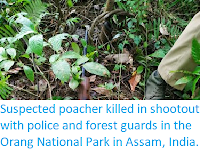Five suspected Rhinoceros poachers have been arrested by the South African Police Service in a raid on a property in the town of Hazyview in Mpumalanga Province on Friday, 4 October 2019. The five men, reported to be between 29 and 52 years old, were wanted in connection with a number of incidents around Ntambanana and Esikhaleni in KwaZulu-Natal during 2018 in which a number of Rhinoceros were killed and their horns removed. Two hunting riffles were also seized during the raid. The men have been remanded in custody till Friday 11 October when they will appear before magistrates for a bail application.
Two riffles seized by South African Police during a raid on a property in Hazyview, Mpumalanga Province in which five suspected Rhinoceros poachers were arrested on 4 October 2019. South African Police Service.
Park authorities and private game reserves across Africa and Asia have been struggling with the problem of Rhino poaching for decades, but the problem has become more acute in recent years, with over a thousand killed in South Africa alone in 2017, and over 5500 in the past five years. The country is home to about 20 000 Rhinos, about 80% of the entire African population. The crime is extremely profitable, and widely believed to be controlled by organised crime syndicates, which are thought to have considerable influence over police and court officials in many areas, which results in suspected poachers often being released before they are brought to trial, often with only nominal bail payments.
South Africa is home to two Rhinoceros species, the Black Rhinoceros, Diceros bicornos, and the Southern White Rhinoceros, Ceratotherium simum simum.
The Black Rhinoceros is considered to be Critically Endangered under the terms of the International Union for the Conservation of Nature's Red List of Threatened Species,
almost entirely on the basis of the threat presented by poachers. The
species formerly roamed across much of Central, East and Southern
Africa, but has been wiped out in many areas. The total population is
thought to have been about 850 000 in 1900, but to have dropped to about
2410 by 1995. Since then the population has benefited from careful
management and protection from poachers, and reaches 4880 in 2010,
though this means that many populations are living in carefully managed
environments rather than being truly wild and free-ranging.
The Southern White Rhinoceros is currently the most common and widespread type of Rhinoceros, with a population estimated at between 17 212 and 18 915 individuals by the conservation organisation Save the Rhino. The species is also found in Botswana, Kenya, Namibia, Swaziland, Zambia, Zimbabwe, and Uganda, but around 90% of the population is located in South Africa, making efforts to protect the species there critical to its long term survival. The Southern White Rhinoceros is currently classified as Near Threatened on the Red List of Threatened Species.
See also...
Follow Sciency Thoughts on Facebook.







